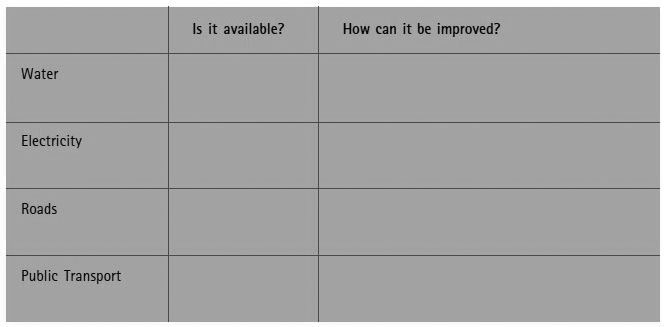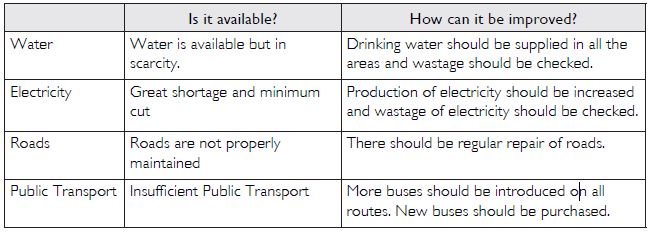Question 1:
Why do you think there are so few cases of private water supply in the world?
Answer:
There are very few cases of private water supply in the world. Following reasons are responsible for the same:
(i) Water is essential for life and for good health.
(ii) One of the most important functions of the government is to ensure public facilities. Supply of
water is also the responsibility of the government.
(iii) The government also gets some money for providing water. But government charges are very
less in comparison to private water supply.
(iv) In the world, where water supply was handed over to private companies, there was a steep rise
in the price of water which was not affordable for many.
(v) In Bolivia, there were riots and protests and government was forced to take back the supply of
water from private hands.
Question 2:
Do you think water in Chennai is available and affordable by all? Discuss.
Answer:
In Chennai, there is a big problem of water and it is neither available nor affordable by all. In posh area like Anna Nagar, there is no shortage of water. But in a majority of the areas, there is a shortage of water and people are facing the scarcity. In Mylapore area, municipal water comes once in two days. Many people purchase water from tankers and spend rupees 500-600 per month. In certain areas, drinking water is supplied once in four days. In Madipabkam area, people buy Bislery Jerry cans. But poor people can’t afford Bislery water. In summer season, the flow of water becomes a trickle. People have to wait long hours for the water tankers.
Question 3:
How is the sale of water by farmers to water dealers in Chennai affecting the local people?
Do you think local people can object to such exploitation of ground water? Can the government do anything in this regard?
Answer:
In Chennai, private companies are taking water from farmers i.e., from their land. This has affected
not only the agriculture but this has also created shortage of drinking water for the villager.
Moreover, water level in these areas have gone very down. Local people have a right to make
protest against exploitation of ground water. To protect public interest, the government can make
rules and regulations to stop the exploitation of ground water.
Question 4:
Why are most of the private hospitals and private schools located in major cities and not in the towns or rural areas?
Answer:
In a modern welfare state like India, it is the responsibility of the government to provide education to the people and to protect the health of the people. Besides the government, the private companies are also providing public facilities especially in big cities. Big private hospitals and private schools are opened in major cities and not in the rural areas. For example, Fortis hospitals, Appollo hospitals, Batra hospitals, etc. Delhi Public School, D.A.V. Public Schools, etc., are located in major cities i.e., Delhi, Mumbai, Kolkata, Chennai, Chandigarh, Gurgaon, Hyderabad, etc. Private hospitals and schools are located in big cities because people in big cities can afford to pay their fees, etc. Private hospitals and schools are very costly and rural people cannot afford their fees, expenditure etc.
Question 5:
Do you think that the distribution of public facilities in our country is adequate and fair? Give an example of your own to explain.
Answer:
One of the most important functions of the government is to ensure that public facilities are made available to everyone. But in our country, the distribution of public facilities is neither adequate nor fair. For example, in Haryana, there is shortage of electricity. Almost eight hours cut is in all the cities of Haryana. But in VIP’s area of each city, there is no such cut. Similar is the case of water. The burden of shortage in water supply falls mostly on the poor.
Question 6:
Take some of the public facilities in your area, such as water, electricity, etc. Is there scope to improve these? What in your opinion should be done? Complete the table.
Answer:
Question 7:
What, in your view, is similar, and what is different in Subramanian’s and Padma’s experiences?
Answer:
Similarities:
(i) They both face water shortage.
(ii) They get water from tankers.
(iii) Both use borewells for water.
Differences:
(i) Padma gets water from borewell from the common tap for 20 minutes twice daily and
Subramanian gets municipal water once in 2 days.
(ii) Padma waits for government tankers whereas Subramanian buys water from tankers.
(iii) Padma uses tanker water for all uses and Subramaniam buys Bisleri water for drinking.
(iv) Padma is a domestic worker and can’t afford to buy water, where as Subramaniam can afford it.
Question 8:
Why does water flow in a trickle in summer in most places in India? Find out.
Answer:
Water flow trickles in summer due to the following reasons:
(i) Demand of water increases in summers, as people need more water for drinking and other purposes.
(ii) Water is also needed for irrigation and for cattle.
(iii) Water bodies dry up in summers due to increased evaporation.
Question 10:
Discuss: Is there a general shortage of water for everyone in Chennai? Can you think of two reasons why different people get varying amounts of water?
Answer:
Chennai is marked with water shortage. On an average, only about 50% of its requirement is fulfilled by the municipal supply. Water is unevenly distributed as:
(i) The areas which are closer to the storage point receive more water than the areas which are far away.
(ii) Middle and upper caste people cope with the shortage of water by various means like buying
water or from underground sources, but the poor face the challenges as they can not afford it.
Question 11:
Discuss: Do you think this would be a right step? What do you think would happen if the government withdraws from the task of supplying water?
Answer:
The shortage of municipal water has been taken as a sign of governments failure and there is demand for privatisation in water supply. This would not be the right step. Throughout the world, water supply is the function of the government and there are very few examples of successful private participation (Porto Alegre Brazil). If the government withdraws, the poor would be affected. Within our country there are successful examples of government water supply like that of Mumbai or Hyderabad where water department increased coverage and improved performance in revenue collection. A limited private participation where government controls the rates may also help improve the supply and distribution.
Question 12:
Discuss the main ideas in the above section. What do you think can be done to improve water supply?
Answer:
This section dealt with successful example of private water supply in Brazil and not so successful example of Bolivia. It also talked about improved supply in Mumbai and Hyderabad. Local authorities can take initiatives like water harvesting recharge ground water, afforestration to improve level of ground water. Leakage can be checked, old rusted pipeline should be replaced, etc. Water treatment plants may be started, wastage of water to be reduced by creating awareness. Fine may be imposed on the people who are found to be wasting water.
Question 13:
Do you think it is also important to conserve resources like water and electricity, and to use more public transport?
Answer:
Yes, it is important to conserve resources and use public transport.
Question 14:
Why do we need new laws?
Answer:
We need new laws to ensure the safety of the people.


